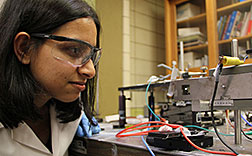- Number 452 |
- November 16, 2015
Biosensor on a chip

Ames Laboratory graduate student Eeshita
Manna inspects an OLED array in the lab.
She and other Ames Laboratory researchers
created an all-organic UV on-chip
spectrometer that can be used in a variety
of applications for sensing and analysis.
When it comes to lighting, LEDs – light-emitting diodes – grab the headlines for energy efficiency and longevity. But for other applications where the light needed falls near the invisible part of the spectrum, a different type of diode may provide the solution. DOE's Ames Laboratory has developed a near ultra-violet and all-organic light emitting diode (OLED) that can be used as an on-chip photosensor.
It’s a first in a rather specialized field of research to capture and manipulate light near the invisible end of the spectrum, around 400 nm in wavelength.
“The real pie in the sky goal is a tiny chip that is a whole spectrometer, so it can measure the absorption or luminescence spectrum of anything that can absorb or emit light. This is a step in that direction,” said Ames Laboratory scientist Joseph Shinar.
While there has been high interest in visible OLEDs as alternatives to conventional LEDs in widely-used applications such as consumer electronics, there has been much less investigation into OLEDs in the ultra-violet spectrum.
“And that has failed to address a rising demand of small-size, flexible devices for analytical applications,” explained Ames Laboratory associate Ruth Shinar, a scientist at Iowa State University’s Microelectronics Research Center.
“Such devices can be used for detection in food safety, water quality, medical diagnosis and other fields where biosensing is necessary. They can be hand-held, used in the field, and potentially inexpensive and disposable.”
Full Story:
https://www.ameslab.gov/news/news-releases/ames-laboratory-scientists-create-all-organic-uv-chip-spectrometer.[Kerry Gibson, 515.294.1405,
kgibson@ameslab.gov]
